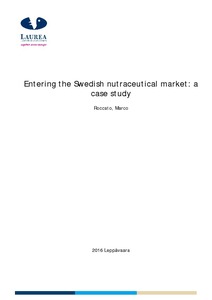Entering the Swedish nutraceutical market: a case study
Roccato, Marco (2016)
Roccato, Marco
Laurea-ammattikorkeakoulu
2016
All rights reserved
Julkaisun pysyvä osoite on
https://urn.fi/URN:NBN:fi:amk-201605167946
https://urn.fi/URN:NBN:fi:amk-201605167946
Tiivistelmä
The purpose of this thesis project was to provide an effective strategy to support the internationalization process to neighbouring countries for a small-sized Finnish nutraceutical distributor. The main point of the work is to provide an effective strategy which is based on the data collected on the market of the country, its main competitors and retailers, distribution and market trends.
The main question of how to enter the Swedish nutraceutical market effectively has been analyzed first in terms of theoretical research, presenting the main theories of internationalization for small- to medium-sized enterprises, particularly regarding internationalization drives and partner selection, which are considered key elements in the case ahead.
A study of the country’s general environment has been conducted using a PESTEL analysis and cultural dimensions to give the company a more detailed understanding of the megatrends affecting the market and the distance in terms of culture between the two neighbors, Finland and Sweden. This study is accompanied by a market analysis that takes into consideration the general trends in the pharmaceutical market, the trends in the segment of OTCs and nutraceuticals and the distribution channels.
The method employed in the market analysis is exclusively quantitative as it presents the main factors in the pharmaceutical and nutraceutical segments by studying dynamics such as sales volumes, market presence in number of stores, competitors’ revenues and market demand.
The peculiarities of the Swedish market, with its former monopoly in the sales of pharmaceuticals and the presence of strong competition, creates the need to present a strategy strongly based on market positioning, giving the opportunity to the company to exploit its premium product to enter the high price segment, a niche market that presents less competition.
In conclusion, the data gathered on the distribution channels and the main retailers with a very polarized outlook has offered the possibility to propose a two stages approach that will help the company effectively gaining market shares.
The main question of how to enter the Swedish nutraceutical market effectively has been analyzed first in terms of theoretical research, presenting the main theories of internationalization for small- to medium-sized enterprises, particularly regarding internationalization drives and partner selection, which are considered key elements in the case ahead.
A study of the country’s general environment has been conducted using a PESTEL analysis and cultural dimensions to give the company a more detailed understanding of the megatrends affecting the market and the distance in terms of culture between the two neighbors, Finland and Sweden. This study is accompanied by a market analysis that takes into consideration the general trends in the pharmaceutical market, the trends in the segment of OTCs and nutraceuticals and the distribution channels.
The method employed in the market analysis is exclusively quantitative as it presents the main factors in the pharmaceutical and nutraceutical segments by studying dynamics such as sales volumes, market presence in number of stores, competitors’ revenues and market demand.
The peculiarities of the Swedish market, with its former monopoly in the sales of pharmaceuticals and the presence of strong competition, creates the need to present a strategy strongly based on market positioning, giving the opportunity to the company to exploit its premium product to enter the high price segment, a niche market that presents less competition.
In conclusion, the data gathered on the distribution channels and the main retailers with a very polarized outlook has offered the possibility to propose a two stages approach that will help the company effectively gaining market shares.
